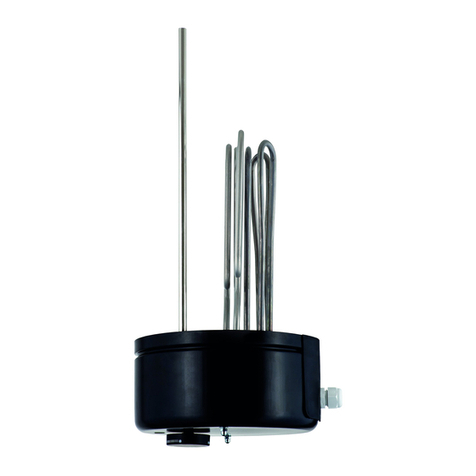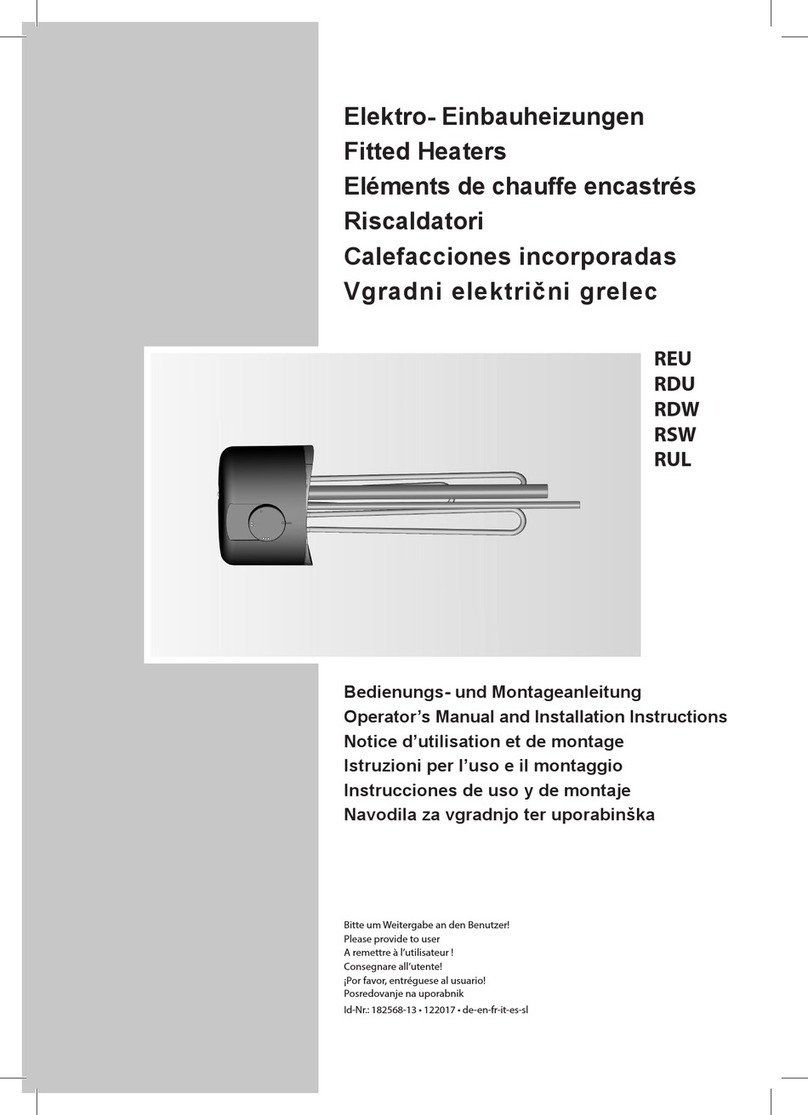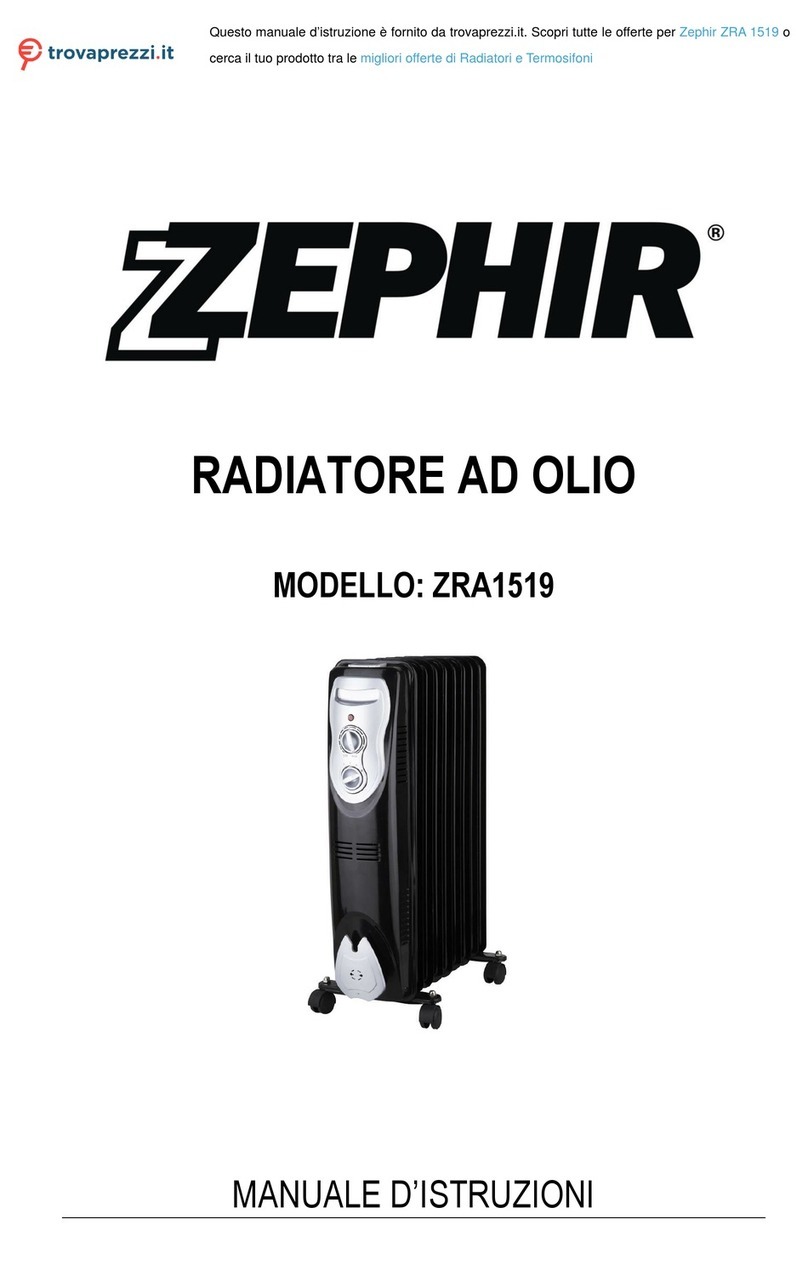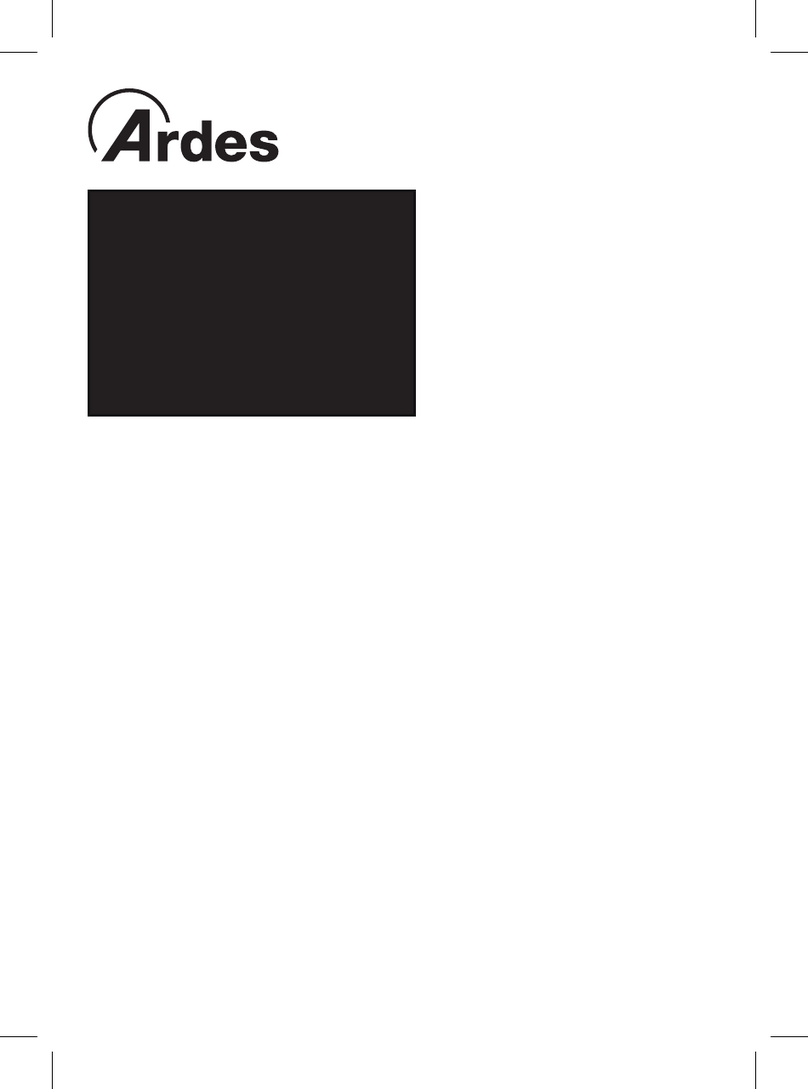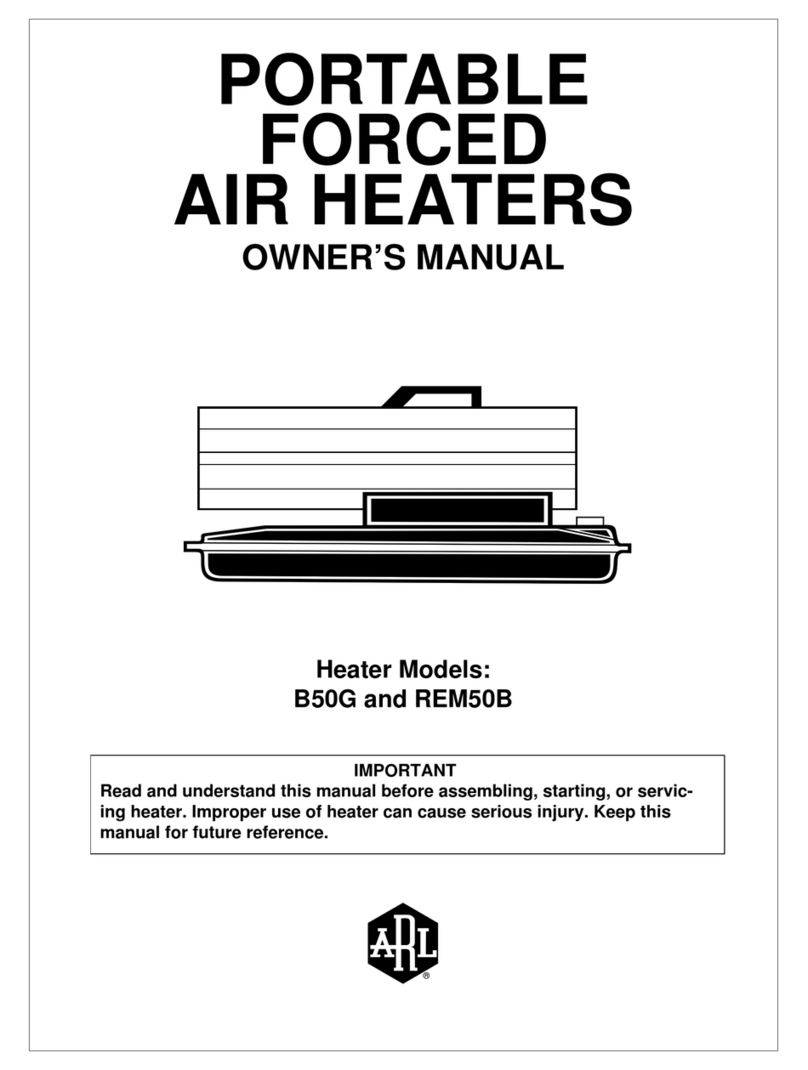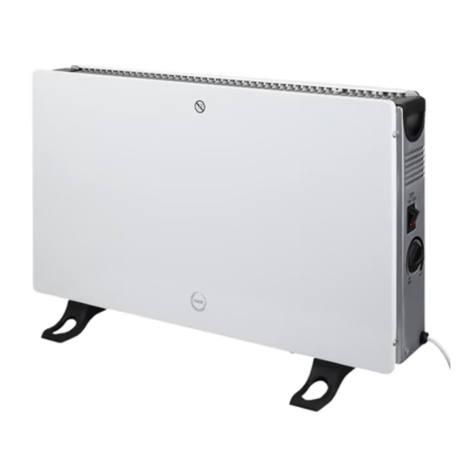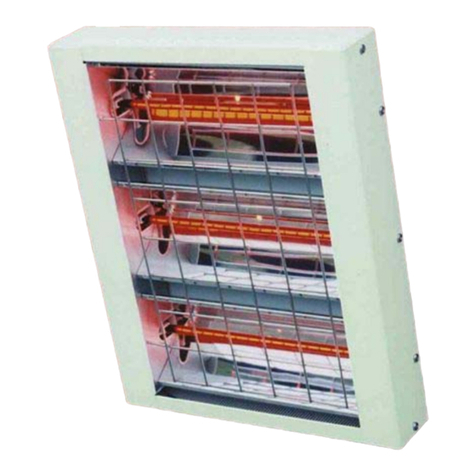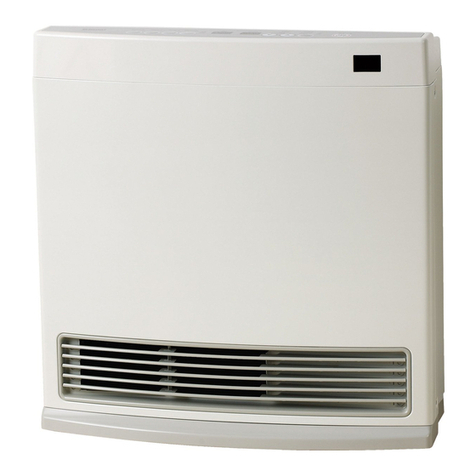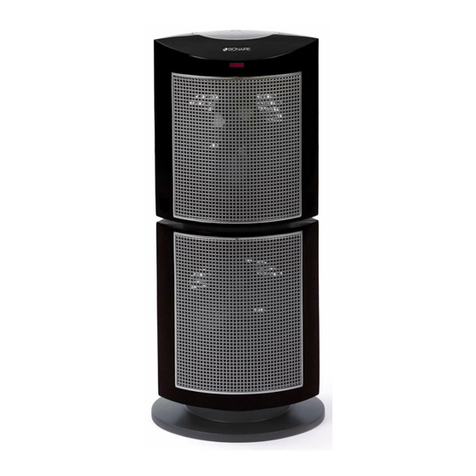Austria Email SH Series User manual

Bedienungs- und Montageanleitung zu
Einschraubheizkörpern der Typenreihe„SH“
Installation and user manual for
“SH” series immersion heaters
Manuale d’installazione ed uso per riscaldatori ad
immersione della serie “SH”
Instrucciones para el montaje y uso de elementos de
calefacción de la serie “SH”
Manuel d’instructions et de montage pour des
éléments de chauage de la série„SH”
Navodila za vgradnjo in uporabniška navodila za
potopni grelec„SH“
BA Austria Email
Seite 2
Page 8
Pagina 14
Página 20
Page 26
Stran 32

2
EINBAU UND SICHERHEITSHINWEISE
1. Die Einschraubheizkörper der Typenreihe SH sind ausschließlich für Zusatzerwärmung von Wasser in ge-
schlossenen oder oenen Behältern konstruiert. Als Hauptheizung sollten Sie eine Elektro-Einbauheizung
mit Flansch der Typenreihe R verwenden.
2. Im Betrieb müssen Heizkörper und Fühlerschutzrohr allseitig ausreichend von Wasser umgeben sein. Die
thermisch bedingte Wasserströmung darf nicht behindert werden.
3. Die Einbaulage der SH ist ausschließlich waagerecht, wobei die 6/4“ Mue max. 100 mm lang sein darf. Vor
der Einbaumue ist ein Platz Einbaulänge + 50 mm für Montage etc. freizuhalten.
4. Die unbeheizte Zone der Einschraubheizkörper beträgt 100 mm ab Dichtäche.
5. Vor sämtlichen Arbeiten am Gerät ist der Heizkörper spannungsfrei zu schalten.
6. Die Umgebungstemperatur am Gehäuse darf 80°C nicht überschreiten.
Type Art.-Nr. Nennleistung
kW
Anschlussspannung
V
Einbautiefe
ab Dichung
Mind. Vol.
des Behälters
SH-1,5 A907 21 1,5 230 320 80 l
SH-2,0 A907 22 2,0 3 - 400 umklemmbar 230 320 80 l
SH-2,5 A907 23 2,5 3 - 400 umklemmbar 230 390 80 l
SH-3,0 A907 24 3,0 3 - 400 umklemmbar 230 390 80 l
SH-3,8 A907 25 3,8 3 - 400 430 80 l
SH-4,5 A907 26 4,5 3 - 400 470 90 l
SH-6,0 A907 27 6,0 3 - 400 620 100 l
SH-7,5 A907 28 7,5 3 - 400 720 200 l
SH-9,0 A907 29 9,0 3 - 400 780 240 l
MONTAGE
Neben den geltenden Normen und Vorschriften sind die Anschlussbedingungen der örtlichen Elektrizitäts- und
Wasserwerke einzuhalten. Der elektrische Anschluss darf nur von einem zugelassenen Elektrofachmann durch-
geführt werden.
1. Vor der Montage ist zu überprüfen, dass sich die Heizstäbe nicht berühren. Gegebenenfalls sind sie von Hand
nachzurichten.
2. Schutzkappe entfernen.
3. Einschraubheizkörper mit beigelegter Flachdichtung in plane Mue einbauen bzw. mit Hanf, PTFE o.ä. ein-
dichten. Hierzu ist ein Maulschlüssel SW 60 einzusetzen. Die Montage mit Hilfe einer Zange o.ä. ist unzulässig.
4. Das Anschlusskabel muss durch die beiliegende Kabelverschraubung in den Anschlussraum des Einschraub-
heizkörpers eingeführt werden. Es ist auf eine ausreichende Dimensionierung des Anschlußkabels zu achten.
5. Elektrischen Anschluss (Iaut Schaltbild) herstellen, auf richtige Anschlussspannung achten. Vor der ersten
Inbetriebnahme ist nochmals die vollständige Verschaltung gemäß Schaltbild zu überprüfen.
6. Die Einschraubheizkörper ab einer Nennleistung von 2 kW sind serienmäßig dreiphasig 3 - 400 Volt in Stern-
schaltung geschaltet und für Direktsteuerung ausgelegt. Der Sternpunkt darf nicht mit dem Schutzleiter
verbunden sein. Der Heizkörper 1,5 kW ist einphasig 230 V geschaltet. Bei Leistungen bis 3kW (siehe Tabel-
le- Anschlussspannung) ist auch ein einphasiger Anschluss mit Direktsteuerung für 230 Volt möglich, wobei
der Heizkörper gemäß Bild 2 verschaltet werden muss. Hierzu ist die am Sternpunkt angebrachte Schraub-
klemme vorgesehen. Dies darf ausschließlich durch einen Elektrofachmann ausgeführt werden. Die Brücken
sind an den Schraubklemmen des Reglers aus 1,5 mm2Kupfer herzustellen
7. Um die Schutzkappe in die gewünschte Position drehen zu können, ist der Deckel abzunehmen und nach
dem Verdrehen wieder festzuziehen. Die Gehäusedichtungen dürfen weder verschoben noch beschädigt
werden. Es müssen die Originalschrauben mit Unterlegscheiben verwendet werden. Eine durch unsachge-
mäße Montage verursachte Undichtigkeit stellt keinen Gewährleistungsfall dar.

3
WICHTIG : NICHT VERGESSEN, DEN SCHUTZLEITER ANZUSCHLIESSEN!
Der Behälter muss mit Wasserein- und Auslaufrohren aus Metall versehen sein und andere berührbare Metallteile
des Behälters, die mit Wasser in Berührung kommen, müssen dauerhaft und zuverlässig mit dem Schutzleiter
verbunden sein. In der elektrischen Zuleitung ist ein allpoliger Trennschalter mit 3 mm Kontaktönungsweite
vorzusehen. Als Trennschaltervorrichtung sind auch Sicherungsautomaten zulässig.
WASSERANSCHLUSS
Die Montage-, Anschluss- und Benutzungsanleitungen des Warmwasserbereiters (-kessels) sind unbedingt ein-
zuhalten. Bei druckfestem Anschluss ist ein geprüftes Membransicherheitsventil oder eine Membransicherheits-
ventilkombination, bei drucklosem Anschluss Rücklauf- und Absperrventil sowie eine Gebrauchsarmatur für
drucklosen Anschluss vorzusehen. Die Möglichkeit einer Trockenheizung ist unbedingt zu vermeiden.
INBETRIEBNAHME
Vor der elektrischen Einschaltung muss der Behälter mit Wasser gefüllt sein. Das erstmalige Aufheizen des Ge-
rätes ist zu überwachen. Während des Aufheizvorganges muss das im Innenkessel entstehende Dehnwasser bei
druckfestem Anschluss aus dem Sicherheitsventil und bei drucklosem Anschluss aus der Überlaufmischbatterie
tropfen. Das selbsttätige Abschalten des Temperaturreglers ist zu kontrollieren.
Im Falle einer Reparatur dürfen ausschließlich Original-Ersatzteile zum Einsatz kommen!
Montageanleitung
Dreiphasiger Anschluss 400V (Lieferzustand) Einphasiger Anschluss 230V (max. 3kW)

4
BENUTZERHINWEISE
1. Je nach Kalkgehalt des Wassers und den Betriebsbedingungen kann es notwendig sein, in gewissen Zeitab-
ständen die Heizkörper vom Kesselstein zu befreien. Der Einbau einer Enthärtungsanlage bzw. Temperatur-
absenkung, wie nachstehend beschrieben, ist zu empfehlen.
Bitte beachten Sie, dass ein durch Verkalkung am Heizkörper entstandener Schaden keinen Gewährleis-
tungsfall für Schäden und Folgeschäden darstellt.
2. Die Behälterwassertemperatur kann entsprechend Ihrem Warmwasserbedarf
mit dem Temperaturwähler stufenlos eingestellt werden. Die maximale Ein-
stelltemperatur beträgt ca. 75 °C. Die minimale Einstelltemperatur beträgt ca.
9 °C und dient somit auch als Frostschutz. Die Schaltdierenz beträgt ca. 10 °C.
Bei einer Einstellung auf 75 °C sinkt die Temperatur also auf ca. 65 °C ab, bevor
der Heizkörper wieder eingeschaltet wird. Um einer übermäßig schnellen Ver-
kalkung des Heizkörpers vorzubeugen, empfehlen wir, den Regler auf eine Tem-
peratur von unter 60 °C einzustellen. Dies entspricht etwa der in der Abbildung
dargestellten Reglerstellung.
3. Sollte im Laufe der Benutzung eine Störung auftreten, so können Sie den Austria Email-Kundendienst ver-
ständigen, oder nach entsprechender Rücksprache einen zugelassenen Elektrofachmann anrufen. Bitte ver-
suchen Sie nicht, Störungen selbst zu beheben. Für Fachleute bedarf es oft nur eines Handgries und Ihr
Einschraubheizkörper ist wieder in Ordnung.
GARANTIE
Garantiedauer
Die Garantiedauer wird grundsätzlich für jedes im Haushalt eingesetzte Gerät entsprechend den gesetzlichen
Vorgaben gewährt. Ein Gerät, das von seiner Bauart für den Haushalt bestimmt ist, aber gewerblich genutzt wird,
hat eine Garantie / Gewährleistung von 6 Monaten. Die Garantiezeit beginnt mit der Übernahme des Gerätes.
Garantiebedingungen
Die Garantieleistung wird mit der Übergabe des Gerätes und der bezahlten Rechnung wirksam. Bewahren Sie
stets neben der vom Verkäufer ausgefüllten Garantieurkunde, die Rechnung, den Lieferschein oder einen ande-
ren Kaufnachweis auf.
Garantievoraussetzung
Voraussetzung für die Garantiepicht ist, dass der Heizkörper nach der Bedienungs- und Montageanleitung und
durch von Austria Email autorisiertes Fachpersonal installiert und sachgemäß bedient worden ist. Das Gerät darf
nicht aus zweiter Hand erworben sein.
Garantie-Inanspruchnahme
Im Fall einer Garantie-Inanspruchnahme ist diese der nächstgelegenen Kundendienststelle / Fachhändler der
Austria Email zu melden. Austria Email behält sich das Recht der Entscheidung vor, ob ein mangelhaftes Teil
ersetzt oder repariert werden soll bzw. ob ein mangelhaftes Gerät gegen ein gleichwertiges mangelfreies Gerät
getauscht wird. Ferner behält sich die Austria Email ausdrücklich vor, vom Käufer die Einsendung der beanstan-
deten Teile oder des Gerätes zu verlangen.
Der Garantiefall ist von Austria Email zu bestätigen. Dazu ist der Einzelfall an Austria Email zu übermitteln.
Ausnahmeregelungen
Nicht zur Inanspruchnahme der Garantieleistungen berechtigen:
• Farbunterschiede
• Normale Abnutzung von Teilen
• Bruch von Glas- und Kunststoteilen
• Solche Abweichungen von der Norm, die den Wert oder die Funktionsfähigkeit nur geringfügig mindern

5
• Transportschäden durch äußere Einüsse
• Mechanische Beschädigungen, Schäden durch Frosteinwirkungen und durch einmalige Überschreitung des
am Leistungsschild angegebenen Betriebsdruckes
• Schäden aufgrund von Trockenbetrieb
• Schäden, die infolge von Verkalkung entstanden sind
• Schäden aufgrund chemischer oder elektrochemischer Einwirkungen
• Schäden aufgrund falscher Spannung, Blitzschlag, Überspannung
• Schäden durch Fremdkörper-Einschwemmungen oder elektromechanische Einüsse
• Korrosionsschäden infolge aggressivem, nicht zum Trinkwassergenuss geeigneten Wassers
• Schäden durch nicht rechtzeitige Erneuerung der Schutzanode des Warmwasserspeichers
• Bei Fremdeingrien ohne ausdrücklichen Auftrag von Austria Email. Auch wenn diese durch einen zugelasse-
nen Elektrofachmann erfolgt, erlischt jeder Garantieanspruch
• Die Übernahme von Reparatur- und Ersatzteilkosten von Dritten wird ausgeschlossen.
• Die Garantiefrist wird durch die Erbringung von Garantieleistungen nicht erneuert oder verlängert
• Über die Garantieleistungen hinausgehende Ansprüche, insbesondere aus Schadens- und Folgeschadenser-
satz werden, soweit dies gesetzlich zulässig ist, ausgeschlossen
• Die Bestimmungen der Allgemeinen Geschäftsbedingungen der Austria Email bleiben, sofern sie durch diese
Garantiebedingungen nicht abgeändert werden, vollinhaltlich bestehen
• Erbrachte Leistungen außerhalb des Rahmens der Garantiebedingungen werden verrechnet
Garantieausschlüsse
Weitergehende oder andere Ansprüche als die vorher genannten aus der Gewährleistung und Garantie sind aus-
geschlossen. Austria Email haftet nicht für Betriebsunterbrechungen, entgangenen Gewinn, Verlust von Daten
und Informationen.
Kosten
Falls eine Reparatur notwendig wird, geben Sie bitte die Garantieurkunde und den Kaufnachweis mit, dabei
gehen die Transportkosten sowie die Verantwortung zu Ihren Lasten. Für die Dauer der Garantiezeit übernimmt
Austria Email die Materialkosten, die der autorisierten Fachwerkstatt anlässlich der Reparatur des Gerätes ent-
stehen. Wird eine Reparatur bei Ihnen zu Hause durchgeführt, werden Ihnen nach Ablauf des ersten Jahres nach
Garantiebeginn die Kosten für die Fahrzeit und für das Kraftfahrzeug in Rechnung gestellt.
GARANTIE ÖSTERREICH
Die Gewährleistung erfolgt gemäß den gesetzlichen Bestimmungen der Republik Österreich sowie der EU.
1. Voraussetzung für die Erbringung von Garantieleistungen durch den Produzenten (im folgenden Prod. ge-
nannt) ist die Vorlage der bezahlten Rechnung für den Ankauf des Gerätes, für welches die Garantieleistung
in Anspruch genommen wird, wobei die Identität des Gerätes hinsichtlich Type und Fabrikationsnummer
aus der Rechnung hervorgehen muss und vom Anspruchswerber vorzuweisen ist. Es gelten ausschließlich
die AGB sowie die Verkaufs- und Lieferbedingungen des Prod.
2. Der Zusammenbau, die Aufstellung, der Anschluss und die Inbetriebnahme des beanstandeten Gerätes
müssen, soweit gesetzlich bzw. wie in der Bedienungs- und Montageanleitung vorgeschrieben, durch einen
konzessionierten Elektrofachmann bzw. Installateur unter Beachtung aller hierfür erforderlichen Vorschrif-
ten erfolgt sein. Der Speicher (ohne Außenmantel oder Kunststo-Außenmantel) muss vor Sonneneinstrah-
lung geschützt werden, um eine Verfärbung des PU-Schaums und eine mögliche Verwerfung von Kunst-
stoteilen zu vermeiden.
3. Der Raum, in dem das Gerät betrieben wird, muss frostfrei sein. Die Montage des Gerätes hat an einem Ort zu
erfolgen mit dem billigerweise zu rechnen ist, d.h. das Gerät muss für den Fall einer notwendigen Wartung,
Reparatur und eventuellem Austausch problemfrei zugänglich und austauschbar sein. Die Kosten für not-
wendige Änderungen der baulichen Gegebenheiten (z.B. zu schmale Türen und Durchgänge) unterliegen
nicht der ausgelobten Garantie und Gewährleistung und werden daher seitens des Produzenten abgelehnt.
Montageanleitung

6
Bei Aufstellung, Montage und Betrieb des Warmwasserbereiters an ungewöhnlichen Orten (z.B. Dachböden,
Wohnräume mit wasserempndlichen Böden, Abstellräume usw.), ist ein eventueller Wasseraustritt zu be-
rücksichtigen und damit eine Vorrichtung zum Auangen und Ableiten des austretenden Wassers vorzuse-
hen, um damit Sekundärschäden im Sinne der Produkthaftung zu vermeiden.
4. In folgenden Fällen erlischt der Anspruch auf Garantie:
Nicht ordnungsgemäßer Transport, normale Abnützung, vorsätzliche oder fahrlässige Beschädigung, Ge-
waltanwendung jeder Art, mechanische Beschädigung, Schäden durch Frost oder durch auch nur einmalige
Überschreitung des am Leistungsschild angegebenen Betriebsdruckes, Verwendung einer nicht der Norm
entsprechenden Anschlussgarnitur oder nicht funktionsfähiger Speicheranschlussgarnitur sowie ungeeig-
neter und nicht funktionsfähiger Gebrauchsarmaturen, Bruch von Glas- und Kunststoteilen, eventuelle
Farbunterschiede, Schäden durch unsachgemäßen Gebrauch, insbesondere durch Nichtbeachtung der
Bedienungs- und Montageanleitung (Bedienungs- und Installationsanleitung), Schäden durch äußeren Ein-
uss, Anschluss an falsche Spannung, Korrosionsschäden in Folge von aggressivem – nicht zum Trinkwas-
sergenuss geeigneten – Wasser entsprechend der nationalen Vorschriften (z.B. der österreichischen Trink-
wasserverordnung TWV – BGBI. II Nr. 304/2001), Abweichungen der tatsächlichen Trinkwassertemperatur an
der Speicherarmatur zur angegebenen Warmwassertemperatur von bis zu 10 K (Hysterese des Reglers und
mögliche Abkühlung durch Rohrleitungen), Weiterbenutzung trotz Auftreten eines Mangels, eigenmächti-
ge Veränderungen am Gerät, Einbau von Zusatzkomponenten, die nicht gemeinsam mit dem Gerät geprüft
wurden, unsachgemäß durchgeführte Reparaturen, zu geringer Leitwert des Wassers (mind. 150 μs/cm), be-
triebsbedingter Verschleiß der Magnesiumanode (Verschleißteil), natürliche Kalksteinbildung, Wasserman-
gel, Feuer, Hochwasser, Überutung und Überschwemmung, Blitzschlag, Überspannung, Stromausfall oder
andere höhere Gewalten, Einsatz von nicht originalen und rmenfremden Komponenten wie z.B. Heizstab,
Schutzanode, Thermostat, Thermometer, Rippenrohrwärmetauscher, usw., gegenüber dem Speicher uniso-
liert eingebrachte Bauteile, Fremdkörpereinschwemmungen oder elektrochemische Einüsse (z.B. Mischin-
stallationen), Nichtbeachtung der Planungsunterlagen, nicht rechtzeitige und dokumentierte Erneuerung
der eingebauten Schutzanode, fehlende oder unsachgemäße Reinigung und Bedienung sowie solche Ab-
weichungen von der Norm, die den Wert oder die Funktionsfähigkeit des Gerätes nur geringfügig mindern.
Grundsätzlich sind auch alle Vorschriften entsprechend der ÖNORM B 2531, der DIN 1988 (EN 806), DIN 1717,
VDI 2035 sowie die entsprechenden nationalen Vorschriften und Gesetze zu befolgen.
5. Im Falle einer berechtigten Reklamation ist diese der nächstgelegenen Kundendienststelle des Prod. zu mel-
den. Diese behält sich die Entscheidung vor, ob ein mangelhafter Teil ersetzt oder repariert werden soll bzw.
ob ein mangelhaftes Gerät gegen ein gleichwertiges mangelfreies Gerät ausgetauscht wird. Ferner behält
der Prod. sich ausdrücklich vor, die Einsendung des beanstandeten Gerätes durch den Käufer zu verlangen.
Der Zeitpunkt einer Reparatur oder eines Austausches wird vom Prod. festgelegt!
6. Garantiereparaturen dürfen nur von Personen, die durch den Prod. dazu bevollmächtigt sind, durchgeführt
werden. Ausgetauschte Teile gehen in das Eigentum des Prod. über. Sollten im Zuge notwendiger Service-
arbeiten etwaige Reparaturen des Warmwasserbereiters notwendig sein, werden diese in Form von Repara-
tur- und anteiligen Materialkosten verrechnet.
7. Bei Fremdeingrien ohne unseren ausdrücklichen Auftrag, auch wenn diese durch einen konzessionierten
Installateur erfolgen, erlischt jeder Gewährleistungsanspruch. Die Übernahme der Kosten für durch Dritte
durchgeführte Reparaturen setzt voraus, dass der Prod. zur Mängelbehebung aufgefordert wurde und ihrer
Verpichtung zu Austausch oder Reparatur nicht oder nicht in angemessener Frist nachgekommen ist.
8. Die Garantiefrist wird durch die Erbringung von Garantie und Gewährleistungsanspruch, Service- und War-
tungsarbeiten nicht erneuert oder verlängert.
9. Transportschäden werden nur dann überprüft und eventuell anerkannt, wenn sie spätestens an dem auf die
Lieferung folgenden Werktag beim Prod. schriftlich gemeldet werden.
10. Über die Garantieleistung hinausgehende Ansprüche, insbesondere solche auf Schaden- und Folgescha-
denersatz, werden, soweit diese gesetzlich zulässig sind, ausgeschlossen. Anteilige Arbeitszeiten für Repara-

7
turen sowie die Kosten für die Instandsetzung der Anlage in den Ausgangszustand müssen vom Käufer zur
Gänze bezahlt werden. Die ausgelobte Garantie erstreckt sich entsprechend dieser Garantieerklärung nur
auf die Reparatur oder den Ersatz des Gerätes. Die Bestimmungen der Verkaufs- und Lieferbedingungen des
Prod. bleiben, sofern sie durch diese Garantiebedingungen nicht abgeändert werden, vollinhaltlich aufrecht.
11. Leistungen, die nicht im Rahmen dieser Garantiebedingungen erbracht werden, werden verrechnet.
12. Voraussetzung für die Einbringung von Garantieleistungen durch den Prod. ist, dass das Gerät einerseits
beim Prod. zur Gänze bezahlt ist und andererseits, dass der Anspruchswerber sämtlichen Verpichtungen
seinem Verkäufer gegenüber voll und ganz nachgekommen ist.
13. Für den emaillierten Innenkessel bei Warmwasserbereitern wird unter vollständiger Aufrechterhaltung der
Garantiebedingungen laut den Punkten 1 bis 12 für den ausgelobten Zeitraum ab Liefertag eine Garantie
geleistet. Werden die Garantiebestimmungen nicht erfüllt, gelten die gesetzlichen Gewährleistungsbestim-
mungen des Auslieferlandes.
14. Zur Erlangung von Ansprüchen nach geltenden Österreichischem Produkthaftungsgesetz bleibt festzuhalten:
Mögliche Ansprüche aus dem Titel der Produkthaftung zur Regulierung von Schäden durch den Fehler eines
Produktes (z.B. ein Mensch wird am Körper verletzt, seine Gesundheit wird geschädigt oder eine vom Pro-
dukt verschiedene körperliche Sache wird beschädigt), sind nur dann gerechtfertigt, wenn alle vorgeschrie-
benen Maßnahmen und Notwendigkeiten, welche zum fehlerfreien und normgerechten Betrieb des Gerätes
notwendig sind, erfüllt wurden. Dazu gehören z.B. der vorgeschriebene und dokumentierte Anodentausch,
der Anschluss an die richtige Betriebsspannung, Schäden durch unsachgemäßen Gebrauch sind zu vermei-
den usw. Diese Vorgaben sind daraus abzuleiten, dass bei Einhaltung aller Vorschriften (Normen, Bedie-
nungs- und Montageanleitung, allgemeine Richtlinien usw.) der den Sekundärschaden kausal auslösende
Fehler am Gerät oder Produkt nicht aufgetreten wäre. Weiters ist es unabdingbar, dass für eine Abwicklung
die notwendigen Unterlagen wie z.B. die Bezeichnung und Herstellnummer des Speichers, die Rechnung
des Verkäufers und des ausführenden Konzessionärs sowie eine Beschreibung der Fehlfunktion, zur labor-
technischen Untersuchung der beanstandete Speicher (unbedingt erforderlich, da ein Sachverständiger
den Speicher untersucht und die Fehlerursache analysiert) beigebracht werden. Um eine Verwechslung des
Speichers am Transport ausschließen zu können, muss der Speicher mit einer gut leserlichen Kennzeichnung
(am besten mit Anschrift und Unterschrift des Endkunden) versehen werden. Eine entsprechende Bilddoku-
mentation über das Schadensausmaß, die Installation (Kaltwasserzuleitung, Warmwasserabgang, Heizungs-
vorlauf bzw. -rücklauf, Sicherheitsarmaturen, gegebenenfalls Ausdehnungsgefäß) sowie die Fehlerstelle
des Speichers ist erforderlich. Ferner behält der Prod. sich ausdrücklich vor, das Beibringen der zu Klärung
notwendigen Unterlagen und Geräte oder Geräteteile durch den Käufer zu verlangen. Voraussetzung zur Er-
bringung von Leistungen aus dem Titel der Produkthaftung ist, dass es dem Geschädigten zur Gänze obliegt
zu beweisen, dass der Schaden durch das Produkt des Prod. verursacht wurde. Ersatzansprüche sind nach
dem Österreichischen Produkthaftungsgesetz überdies nur mit dem 500 Euro übersteigenden Teil gerecht-
fertigt (Selbstbehalt). Bis zur Klärung des gesamten Sachverhaltes und der Umstände sowie der Ermittlung
der kausal fehlerauslösenden Ursache, wird ein mögliches Verschulden des Prod. dezidiert ausgeschlossen.
Ein Nichtbefolgen der Bedienungs- und Montageanleitung sowie der einschlägigen Normen ist als Fahrläs-
sigkeit zu werten und führt zu einem Haftungsausschluss im Bereich des Schadenersatzes.
Die Abbildungen und Daten sind unverbindlich und können im Sinne der technischen Verbesserungen kom-
mentarlos abgeändert werden.
Druckfehler und technische Änderungen vorbehalten.
Montageanleitung

8
INSTALLATION AND SAFETY INSTRUCTIONS
1. The SH series of immersion heater s are designed exclusively for the auxiliary heating of water in closed or
open containers. A built-in electric heater with ange of the R series should be used as the main heater.
2. During operation, the heating element and sensor tube must be suciently immersed from all sides in wa-
ter. The thermally induced water ow may not be impeded.
3. The SH must be installed in horizontal positions only, the length of the 6/4“ tting may not exceed 75mm. An
area in front of the tting equal to the installation length + 50mm is to be kept clear for mounting, etc.
4. The unheated zone of the immersion heater amounts to 100 mm from the sealing surface.
5. The heating element is to be disconnected from the power supply prior to any work on the appliance.
6. The ambient temperature at the casing may not exceed 80°C.
Type Item-Id Rated
power kW
Input supply Voltage
V
Installation
depth from seal
Min. Vol. of
container
SH-1,5 A907 21 1,5 230 320 80 l
SH-2,0 A907 22 2,0 3 - 400 reconnectable 230 320 80 l
SH-2,5 A907 23 2,5 3 - 400 reconnectable 230 390 80 l
SH-3,0 A907 24 3,0 3 - 400 reconnectable 230 390 80 l
SH-3,8 A907 25 3,8 3 - 400 430 80 l
SH-4,5 A907 26 4,5 3 - 400 470 90 l
SH-6,0 A907 27 6,0 3 - 400 620 100 l
SH-7,5 A907 28 7,5 3 - 400 720 200 l
SH-9,0 A907 29 9,0 3 - 400 780 240 l
INSTALLATION
In addition to the eective norms and regulations, the connection requirements of the local power station and
water supply company are to be observed. The electrical connection may only be established by a licensed elec-
trician.
1. Prior to installation, ensure that the heating rods do not touch one another. If necessary, adjust them by
hand.
2. Remove the protective cap.
3. Install the immersion heater with the supplied at gasket into the planar tting and/or seal with hemp, PTFE
or similar. Use a SW60 open-jawed wrench for this. Installation using pliers or the like is not permitted.
4. The connection cable must be inserted through the accompanying screwed cable gland into the connection
space of the immersion heater. The connection cable must be of a sucient rating.
5. Establish the electrical connection (according to circuit diagram), ensure the connection voltage is correct.
The entire wiring must be checked according to the circuit diagram before initial operation of the appliance.
6. The immersion heater with a rated power of 2 kW upwards are by default y-connected three-phase systems
of 3 - 400 Volts, designed for direct control. The neutral point may not be connected to ground. The 1.5 kW
heating element is wired for monophase 230V. For power ratings up to 3 kW (see table: mains voltage), a
mono- phase connection with direct control for 230 Volts is possible, whereby the heating element must be
connected according to gure 2. The provided terminal screw at the neutral point is intended for this pur-
pose. This may only be performed by a licensed electrician. The bridges are to be established at the terminal
screws of the regulator using 1.5mm2copper.
7. To be able to rotate the protective cap to the desired position, remove the cover and tighten it again after
rotation. The housing seals must not be displaced or damaged. Only the original screws with washers may
be used. A leakage due to improper installation does not represent a warranty situation.

9
IMPORTANT: DO NOT FORGET TO CONNECT THE GROUND!
The container must be tted with water inlet and outow tubes made from metal and other touchable metal
parts of the container which come into contact with water must be permanently and reliably connected to
ground. An all-pole disconnecting switch with 3 mm contact gaps must be tted in the power supply feed. Auto-
matic circuit breakers are also acceptable as isolating switch mechanisms.
WATER CONNECTION
The installation, connection and user instructions for the water heater (boiler) are to be followed at all costs. In
the case of a pressurized connection, a certied membrane safety valve or a membrane safety valve combination
is required. In the case of an unpressurized connection, a return valve, a stop valve as well as service ttings for
unpressurized connections are required. The possibility of dry heating is to be avoided at all costs.
INITIAL OPERATION
The container must be lled with water before the electricity is turned on. The rst-time
heating of the appliance must be monitored. During the heating process, the expanded water produced in the
interior boiler must drip from the safety valve in the case of a pressurized connection and from the overow
mixing faucet in the case of an unpressurized connection. The automatic cutout function of the thermostat must
be checked.
When repair becomes necessary, only use original replacement parts!
Installation manual
Three-phase connection 400V (delivery condition) Monophase connection 230V (max. 3kW)

10
CONSIDERATIONS FOR USE
1. Depending on the lime content of the water and the operating conditions, it may be necessary to free the
heating elements from boiler scale at regular intervals.
It is recommendable to install softening equipment or a temperature reduction, as described in the follo-
wing. Please note that damage to the heating element caused by calcication does not represent a warranty
situation for damages or consequential damages.
2. The container water temperature can be continuously adjusted using the tem-
perature selector to match your warm water requirements. The maximum tem-
perature setting is ca. 75°C. The minimum temperature setting is ca. 9°C and
thus also serves as protection against freezing. The dierential gap amounts to
ca. 10°C. So, when set to 75°C, the temperature will sink to ca. 65°C, before the
heating element is switched on again. To prevent overly rapid calcication of
the heating element, we recommend setting the temperature to below 60°C.
This roughly matches the position of the temperature control shown in the gu-
re below.
3. Should a failure occur during use, you may inform the Austria Email customer service, or after appropriate
consultation, call a licensed electrician. Please do not attempt to repair a fault yourself. For professionals, it
usually just takes a few moments and your immersion heater is working again.
WARRANTY
Warranty period
The warranty period is prescribed by law for all household appliances. An appliance that is designed for the
household but is used commercially has a warranty of 6 months. The warranty period begins with the acceptance
of the appliance.
Terms of warranty
The warranty takes eect with the acceptance of the appliance and the settling of the invoice. Always retain the
warranty certicate that was lled out by the vendor, the invoice, the delivery note or other proof of purchase.
Warranty requirements
Eective warranty requires that the heating element was installed according to the installation and operating
instructions by qualied personnel authorized by Austria Email and that it was properly operated.
The appliance may not have been purchased second-hand.
Warranty claims
If warranty claims are to be demanded, the nearest customer service location or authorized dealer of Austria
Email must be notied. Austria Email reserves the right to decide whether a faulty part shall be replaced or repai-
red, or whether a faulty appliance shall be exchanged with an equivalent, faultless appliance. Moreover, Austria
Email reserves the right to demand that the customer send in the rejected parts or the appliance. Austria Email
must conrm a case of warranty. For this purpose, the individual case must be transmitted to Austria Email.
Exceptions
The following do not entitle the customer to a warranty claim:
• color dierences
• normal wear and tear
• broken glass and plastic parts such deviations from the norm that only insignicantly reduce the value or the
operability
• transport damages due to extraneous causes
• mechanical damages, damages caused by frost and damages caused by one-time exceeding of the operating
pressure stated on the rating plate

11
• damages caused by dry operation
• damages caused by calcication
• damages due to chemical or electrochemical inuences
• damages due to incorrect voltage, lightning stroke, voltage surges
• damages caused by the intrusion of foreign objects or electromechanical inuences
• corrosion damage due to aggressive, non-potable water
• damages caused by delayed renewal of the protective anode of the hot water tank
• In the case of third-party interventions not expressly ordered by Austria Email, the warranty shall become null
and void even if this intervention is by a licensed electrician.
• Austria Email shall not accept repair and replacement part costs from third parties.
• The provision of warranty services does not renew or prolong the warranty period.
• Claims going beyond the warranty, in particular claims for damages and consequential damages, are excluded
to the extent to which this is lawfully permitted.
• The general terms and conditions of Austria Email shall remain applicable in their entirety to the extent to
which they are not altered by these terms of warranty. Services performed outside the scope of the terms of
warranty shall be charged.
Warranty exclusions
Claims going beyond or claims dierent from those mentioned above for the warranty are excluded. Austria
Email shall not be liable for business interruptions, loss of prot, loss of data and information.
Costs
In cases where a repair becomes necessary, please provide the warranty certicate and proof of purchase; trans-
port costs and responsibility are for your account. During the warranty period, Austria Email shall bear the ma-
terial costs that arise from the repair of the appliance by an authorized workshop. If repair is performed at your
home, the costs for the journey time and for the vehicle shall be invoiced to you after the end of the rst year of
the warranty period.
WARRANTY AUSTRIA
Warranty is made according to the legal provisions of the Republic of Austria and the EU.
1. The prerequisite for honoring of warranty terms on the part of the manufacturer (hereinafter referred to as
Manufacturer) is presentation of a paid invoice for the purchase of the appliance in question, whereby the
identity of the appliance including model and fabrication number must be indicated on the invoice and pre-
sented by the claim applicant. The General Terms and Conditions, Terms and Conditions of Sale and Delivery
of the manufacturer shall apply exclusively.
2. The assembly, installation, wiring and startup of the appliance in question must, to the extent that this is
prescribed legally or in the installation and operation guide, have been performed by an authorized electri-
cal technician or installer who has followed all the required regulations. The hot water tank (excluding outer
jacket or plastic cover) must be protected from exposure to direct sunlight to prevent discoloration of the
polyurethane foam and possible cracking of plastic parts.
3. The area in which the appliance is operated must be kept from freezing. The unit must be installed in a
location where it can be easily accessed for maintenance, repair and possible replacement. The costs for any
necessary changes to the structural conditions (e.g. doors and passages too narrow) are not governed by
the guarantee and warranty declaration and therefore shall be rejected on the side of manufacturer. When
erecting, installing and operating the water heater in unusual locations (e.g. attics, interior rooms with wa-
ter-sensitive oors, closets, etc.), provision must be made for possible water leakage and means provided for
catching the water with a corresponding drain to avoid secondary damage in the context of product liability.
4. Warranty claims will not be honored for:
inappropriate transport, normal wear and tear, intentional or negligent damage, use of force of any kind or
Installation manual

12
description, mechanical damage or damage caused by frost or also by exceeding the operating pressure
stated on the rating plate, even if only once, use of connection ttings that do not comply with the standard,
use of defective tank connection ttings and unsuitable and defective service ttings. Breaking of glass and
plastic components, possible colour dierences, damage due to improper use, in particular non-observance
of the mounting and operating instructions (Operating and Mounting Instructions), damage by external
inuence, connecting to incorrect voltage, corrosion damage as a consequence of aggressive waters (water
not suitable for drinking) in accordance with the national regulations (e.g. Austrian ordinance on drinking
water, TWV – Fed. Law Gazette II No. 304/2001), deviations between the actual drinking water temperature
at the tank tting and the specied hot water temperature of up to 10K (hysteresis of the controller and
possible cooling due to pipelines), Continued use, despite the occurrence of a defect, unauthorised modi-
cations to the device, installation of additional components that were not tested together with the device,
improperly carried out repairs, Insucient water conductivity (min. 150 µs/cm) operational wear of the ma-
gnesium anode (wearing part), natural formation of boiler scale, lack of water, re, ood, lightning, overvol-
tage, power failure or other types of force majeure. Use of non-original and company-external components
such as e.g. heating elements, reactive anode, thermostat, thermometer, ribbed tube heat exchanger, etc.,
Parts installed in an uninsulated condition with respect to the storage tank, ingress of foreign particles or
electrochemical inuences (e.g. mixed installations), failure to observe the design documents, unpunctual
and undocumented renewal of the installed protective anode, no or improper cleaning and operation, as
well as any deviations from the standard that reduce the value or functionality of the device only slightly.
Fundamental compliance with all regulations in ÖNORM B 2531, DIN 1988 (EN 806), DIN 1717, VDI 2035 or
the corresponding national regulations and laws must be ensured.
5. A justied claim must be reported to the closest customer service location of the manufacturer. The latter
reserves the right to replace or repair a defective part or to decide whether a defective appliance shall be
replaced with a working one of equal value. The manufacturer furthermore expressly reserves the right to
require that the purchaser return the appliance in question. The time of a repair or a replacement is deter-
mined by the production.
6. Repairs made under warranty are to be performed only by persons authorized by the manufacturer. Repla-
ced parts become the property of the manufacturer. If any repairs to the water heater become necessary as
part of necessary service work, these are charged at the cost of repair and prorated material cost.
7. Any work performed without our express order, even this is done by an authorized installer, will void the
warranty. Assumption of the costs for repairs performed by third parties presumes that the manufacturer
was requested to eliminate the defect and did not or did not in timely fashion meet his obligation for repla-
cement or repair.
8. The warranty period will not be renewed or extended as a result of a guarantee and warranty claim, service
or maintenance work.
9. Transport damage will only be inspected and if appropriate recognized if it has been reported in writing to
the manufacturer no later than the weekday following delivery.
10. Claims exceeding the terms of the warranty, in particular those for damage and consequential damages,
are precluded insofar as these are legally permissible. Pro rata work times for repairs as well as the costs for
restoring the equipment to its original condition must be paid in full by the purchaser. The guarantee provi-
ded extends according to this guarantee declaration only to the repair or replacement of the appliance. The
provisions of the Terms of Sales and Delivery of the manufacturer remain, insofar as they are not altered by
these guarantee conditions, fully in eect.
11. There is a charge for services provided outside of the context of these guarantee conditions.
12 In order for a warranty claim to be honored by the manufacturer, the appliance must be paid for in full to the
manufacturer and the claimant must have met all his obligations to his vendor in full.

13
13. The enamelled internal boiler for water heaters is warranted for the specied period from the delivery date
provided all warranty terms described under Points 1 to 12 are observed with in full. If the warranty terms
have not been met, the legal warranty requirements of the respective country from which the appliance was
shipped shall prevail.
14. Claim satisfaction according to prevailing Austrian Product Liability Law:
Claims for compensation under the title of product liability are only justied if all prescribed measures and
necessities for fault-free and approved operation of the appliance have been met. This includes among other
things the prescribed and documented anode replacement, connection to proper operating voltage, pre-
vention of damage due to improper use, etc. From these conditions it can be concluded that if all requi-
rements are met (norms, installation and operation guide, general guidelines, etc.), the device or product
fault resulting in the secondary damages would not have occurred. Furthermore it is mandatory that for
processing of the claim the necessary documentation such as the part number and manufacturing number
of the water heater, the seller’s invoice and that of the executing license holder as well as a description of the
malfunction for a laboratory study of the appliance in question (absolutely required, since a specialist will
study the appliance and analyze the cause of failure) be provided. To prevent misidentication of the water
heater during transport, it must be marked with a highly visible and legible marking (preferably including
address and signature of the end customer). Corresponding pictorial documentation indicating the extent of
the damage, the installation (cold water line, hot water outlet, heating outgoing and return, safety xtures,
expansion tank if present) as well as the defect location on the water heater is also required. Furthermore
the manufacturer reserves the express right to require that the purchaser provide all the documents and
equipment and equipment parts necessary for clarication. The prerequisite for performing services under
the title of product liability is that it is the claimant’s obligation to prove that the damage was caused by the
manufacturer’s product. Damage compensation according to the Austrian Product Liability Law is subject to
a 500 Euro deductible. Until the entire matter is claried and the circumstances as well as determination of
the causal factors are established, the manufacturer is held faultless. Non-observance of the operating and
installation guide and/or the relevant norms is considered negligent and will result in a liability disclaimer
within the scope of compensation for damages.
The illustrations and data are not binding and may be modied without notice when technical improvements
are made.
Subject to printing errors and technical changes.
Installation manual

14
AVVERTENZE DI MONTAGGIO E DI SICUREZZA
1. I riscaldatori ad immersione della serie SH vanno impiegati esclusivamente per il riscaldamento supplemen-
tare dell’acqua in serbatoi chiusi o aperti. Per il riscaldamento primario si prega di ricorrere ad un riscaldatore
elettrico a angia della serie R.
2. Una volta in servizio, il riscaldatore e il tubo di protezione del sensore devono essere sucientemente im-
mersi nell’acqua. La corrente termicamente stimolata non può essere ostacolata.
3. Il modello SH va montato solo in posizione orizzontale. Il manicotto 6/4“ può essere lungo no a 75 mm. Da-
vanti al manicotto va previsto uno spazio libero pari alla lunghezza di installazione + 50 mm per il montaggio
ecc.
4. La zona non riscaldata del riscaldatore ad immersione è di 100 mm a partire dalla supercie di tenuta.
5. Prima di eseguire operazioni di qualsiasi tipo sul riscaldatore, sconnettere l’apparecchio e assicurarsi che sia
privo di tensione.
6. La temperatura ambiente sul corpo del riscaldatore non può superare i 80°C.
Tipo N° art. Potenza
nominale kW
Tensione V Altezza di montaggio
della fuarnizione
Volume min.
SH-1,5 A907 21 1,5 230 320 80 l
SH-2,0 A907 22 2,0 3 - 400 commutabile 230 320 80 l
SH-2,5 A907 23 2,5 3 - 400 commutabile 230 390 80 l
SH-3,0 A907 24 3,0 3 - 400 commutabile 230 390 80 l
SH-3,8 A907 25 3,8 3 - 400 430 80 l
SH-4,5 A907 26 4,5 3 - 400 470 90 l
SH-6,0 A907 27 6,0 3 - 400 620 100 l
SH-7,5 A907 28 7,5 3 - 400 720 200 l
SH-9,0 A907 29 9,0 3 - 400 780 240 l
MONTAGGIO
Oltre alle norme e prescrizioni vigenti, vanno rispettate le norme tecniche di allacciamen- to dei rispettivi enti
locali di fornitura elettrica e idrica. L’allacciamento alla rete elettrica può essere eseguito solo da un elettricista
competente e qualicato.
1. Prima di procedere al montaggio, vericare che le resistenze elettriche non si tocchino e, se necessario, ag-
giustarne manualmente la posizione.
2. Rimuovere il cappuccio di protezione.
3. Inserire i riscaldatori ad immersione con annessa guarnizione piatta in un manicotto, ovvero sigillare con
canapa, PTFE o simili, usando una chiave ssa SW60. Non è consentito utilizzare tenaglie o altri simili stru-
menti.
4. Inlare il cavo di allacciamento attraverso il pressacavo (compreso nella fornitura) nell’apertura di collega-
mento del riscaldatore ad immersione. Il cavo di allacciamento deve essere adeguatamente dimensionato.
5. Realizzare la connessione elettrica (come da schema elettrico) prestando attenzione alla giusta tensione di
alimentazione. Prima di mettere in servizio l’apparecchio per la prima volta, vericare nuovamente che la
connessione corrisponda a quanto indicato nello schema elettrico.
6. I riscaldatori ad immersione a partire da una potenza nominale di 2 kW hanno di serie una connessione a
stella con componente trifase 3 - 400 Volt e sono predisposti per il comando diretto. La connessione a stella
non può essere collegata con il cavo di terra. Il riscaldatore 1,5 kW è monofase 230V. A potenze di no a 3 kW
(s.v. tabella tensione di alimentazione) è inoltre possibile un collegamento monofase con comando diretto
per 230 Volt; in questo caso, il riscaldatore va connesso come indicato nella gura 2, con il morsetto a vite ap-
positamente presente nel punto di connessione a stella. L’operazione può essere eseguita solo da un elett-
ricista competente. I collegamenti a ponte sui morsetti a vite del regolatore devono essere in rame 1,5mm2.

15
7. Per ruotare il cappuccio di protezione nella posizione desiderata, rimuovere il coperchio e serrarlo nuova-
mente a operazione compiuta. Evitare di spostare o danneggiare le guarnizioni del corpo del riscaldatore!
Utilizzare le viti e le rondelle originali. La garanzia non copre eventuali perdite di tenuta dovute ad un mon-
taggio inadeguato.
IMPORTANTE: RICORDARSI DI COLLEGARE LA MESSA A TERRA!
Il serbatoio deve essere dotato di tubi in metallo per il carico e lo scarico dell’acqua; tutte le parti metalliche ac-
cessibili e in contatto con l’acqua devono sempre essere collegate in maniera sicura con la messa a terra. Il cavo
di alimentazione elettrica va munito di sezio- natore onnipolare con un’apertura del contatto larga 3 mm. Invece
di un sezionatore, può essere impiegato anche un dispositivo automatico di protezione.
ALLACCIAMENTO IDRICO
Si raccomanda di attenersi alle istruzioni per il montaggio, l’allacciamento e l’uso dello scaldacqua (della caldaia).
Per un allacciamento sotto pressione, servirsi di una valvola di sicurezza a membrana omologata o di una com-
binazione di valvole di sicurezza a membrana, per un allacciamento non sotto pressione di una valvola di non
ritorno / di chiusura e di una valvola comune per l’allacciamento non sotto pressione. Evitare che lo scaldacqua
funzioni a secco.
MESSA IN SERVIZIO
Prima dell’accensione elettrica, il serbatoio deve essere riempito d’acqua. Controllare la prima fase di riscalda-
mento dell’apparecchio. In fase di riscaldamento, a seguito della dilatazione all’interno del serbatoio deve sgoc-
ciolare dell’acqua dalla valvola di sicurezza (allacciamento a tenuta di pressione) ovvero dalla valvola di troppo-
pieno (allacciamento non sotto pressione). Va inoltre controllato lo spegnimento automatico del regolatore di
temperatura.
Per ogni riparazione utilizzare esclusivamente pezzi di ricambio originali!
Manuale d’installazione
Connessione trifase 400V (stato di consegna) Connessione monofase 230 V (max. 3kW)

16
ISTRUZIONI PER L’USO
1. A seconda del grado di durezza dell’acqua e delle condizioni d’uso, può essere necessario rimuovere periodi-
camente il calcare formatosi sul riscaldatore. È consiglia- bile installare un impianto d’addolcimento ovvero
di riduzione della temperatura come descritto qui di seguito. Attenzione: la garanzia non copre eventuali
danni diretti o indiretti dovuti ad un accumulo di calcare sul riscaldatore.
2. A seconda delle proprie esigenze, la temperatura dell’acqua nel serbatoio può
essere regolata senza soluzione di continuità con l’apposito regolatore di tem-
peratura. La temperatura massima regolabile è pari a ca. 75°C, quella minima a
ca. 9°C - garan- tendo così anche la funzione antigelo. La dierenza di commuta-
zione corrisponde a ca. 10°C, vale a dire che se la temperatura impostata è di
75°C, essa scende no a ca. 65°C prima che il riscaldatore si riaccenda. Per preve-
nire un accumulo eccessiva- mente rapido di calcare sul riscaldatore, si consiglia
di impostare una temperatura inferiore ai 60°C, come indicato nella gura qui di
seguito.
3. In presenza di disturbi in fase d‘uso dell‘apparecchio, informare il servizio assistenza clienti Autria Email o
contattare (previa comunicazione) un eletricista qualicato. Non tentare di riparare il guasto. Spesso, infatti,
al tecnico specializzato bastano cinque minuti e il riscaldatore ad immersione è di nuovo perfettamente
funzionante.
GARANZIA
Durata della garanzia
La durata della garanzia corrisponde a quella della garanzia a norma di legge per ogni apparecchio d’uso dome-
stico. Per gli apparecchi del tipo predisposto per l’uso domesti- co ma impiegati in vani commerciali la garanzia
dura 6 mesi. La garanzia decorre dalla data della presa in consegna dell’apparecchio.
Condizioni di garanzia
La garanzia è valida dal momento della consegna dell’apparecchio, ovvero dalla data del saldo della relativa
fattura. Si raccomanda di conservare, oltre al certicato di garanzia consegnato dal venditore, la fattura, la bolla
di consegna e ogni altra ricevuta d’acquisto.
Validità della garanzia
La garanzia è valida solo a condizione che il riscaldatore sia stato montato e messo in servizio in modo adeguato
e secondo le istruzioni per l’installazione e l’uso da parte di personale specializzato autorizzato di Austria Email.
La garanzia non vale per apparecchi acquistati di seconda mano.
Interventi in garanzia
Qualsiasi richiesta di intervento in garanzia va inoltrata al servizio assistenza clienti / rivenditore autorizzato di
Austria Email più vicino. Austria Email si riserva il diritto di deci- dere se un pezzo difettoso sia da sostituire o da
riparare, ovvero se un apparecchio difettoso debba essere ritirato dietro consegna di un equivalente apparecchio
funzionante.
Austria Email si riserva inoltre espressamente il diritto di richiedere al cliente la spedizione dei pezzi o dell’ap-
parecchio difettosi. L’intervento in garanzia deve essere confermato da Austria Email. Per questo motivo, ogni
singolo caso va comunicato a Austria Email.
Eccezioni
Non autorizzano a richiedere un intervento in garanzia i seguenti casi:
• Dierenza di colori
• Normale usura dei pezzi
• Rottura di pezzi in vetro e/o plastica

17
• Deviazioni dalla norma che comportano una riduzione solo marginale del valore o della funzionalità dell’ap-
parecchio
• Danni dovuti a fattori esterni durante il trasporto
• Danni meccanici, danni dovuti al gelo e ad un unico caso di superamento della pressione di esercizio indicata
nella targhetta dei dati
• Danni dovuti al funzionamento a secco
• Danni dovuti ad un accumulo di calcare
• Danni dovuti ad inussi chimici o elettrochimici
• Danni dovuti ad una scorretta tensione, a fulmini, a sovraccarico di tensione
• Danni dovuti alla presenza di corpi estranei o di inussi elettromeccanici nel serbatoio
• Danni di corrosione dovuti all’impiego di acqua aggressiva non potabile
• Danni dovuti alla mancata o ritardata sostituzione dell’anodo di protezione dello scaldacqua
• In caso di interventi non espressamente autorizzati da Austria Email, anche nel caso tali interventi siano stati
eseguiti da parte di un elettricista qualicato, decade ogni diritto alla garanzia.
• Non ci si assume spese per riparazioni o pezzi di ricambio ad opera di terzi. È esclus il rinnovo o il prolungamen-
to del termine di garanzia in caso di intervento in garanzia.
• È escluso ogni diritto non rientrante nei termini di garanzia, ed in particolare il rimborso di danni diretti ed
indiretti, nella misura in cui ciò sia consentito a norma di legge.
• Le Condizioni Generali di Vendita di Austria Email mantengono la loro completa validità salvo nei casi in cui
esse siano modicate dalle presenti condizioni di garanzia.
• Tutti i servizi prestati non coperti da garanzia saranno regolarmente fatturati.
Esclusioni dalla garanzia
Sono escluse tutte le rivendicazioni non comprese o diverse dalle condizioni di garanzia sopra elencate.
Austria Email non risponde di eventuali interruzioni di funzionamento, mancato guadagno, perdita di dati o di
informazioni.
Spese
In caso si renda necessaria una riparazione, si prega di includere nella spedizione anche il certicato di garanzia
e la ricevuta d’acquisto; il cliente risponde del trasporto e ne sostiene le spese. Per tutta la durata della garanzia,
Austria Email si assume le spese per i materiali utilizzati per la riparazione dell’apparecchio presso un’ocina
specializzata e autorizzata. In caso di intervento di riparazione presso la sede del cliente, allo scadere del primo
anno dalla data di inizio della garanzia le spese di trasporto (su base oraria e per il combustibile) saranno fatturate
al cliente.
GARANZIA AUSTRIA
La prestazione di garanzia avviene in base alle disposizioni legali in materia della Repubblica Federale Austriaca
e dell’UE.
1. l Produttore (denominato in seguito Produttore) presta garanzia a condizione che venga presentato lo
scontrino o fattura d‘acquisto dell‘apparecchio/ serbatoio, per il quale si richiede la prestazione di garanzia,
sempre tenendo conto che l‘identità dell’apparecchio/serbatoio relativa a modello e numero di fabbricazio-
ne dev’essere specicata nella fattura e comprovata da chi richiede la prestazione in questione. Si applicano
esclusivamente le condizioni d’ordine, di vendita e di fornitura del produttore.
2. L’assemblaggio, la collocazione, il collegamento/allacciamento e la messa in esercizio dell’apparecchio/ser-
batoio contestato devono essere eettuati, come legalmente prescritto o riportato nelle istruzioni per l’uso
ed il montaggio, da un elettricista specialista autorizzato o installatore tenendo conto di tutte le inerenti
prescrizioni necessarie. Il serbatoio (senza rivestimento esterno o rivestimento esterno in materiale sintetico)
dev’essere protetto dai raggi del sole evitando cosi uno scolorimento dell’espanso in PU o una deformazione
delle parti in materiale sintetico.
3. L’ambiente, in cui si fa uso del serbatoio, dev’essere senza gelo. Il montaggio del serbatoio deve avere luogo
in un ambiente, in cui gli eventuali interventi non comportano spese elevate, sarebbe a dire che, in caso di
Manuale d’installazione

18
un necessario intervento di manutenzione, riparazione e di eventuale sostituzione, vi si può accedere senza
problema alcuno. Le spese per le modiche necessarie delle strutture architettoniche (p.es. porte e passaggi
troppo stretti) non fanno parte della garanzia oerta e non vengono riconosciute dal produttore. Se il serba-
toio per la produzione d’acqua calda viene collocato, assemblato e messo in esercizio in luoghi insoliti (p. es.
nelle sotte, stanze ad uso abitativo con pavimenti idrosensibili, ripostigli ecc.), allora si dovrà tenere conto
di un’eventuale fuoriuscita dell’acqua e quindi di un idoneo dispositivo che possa raccoglierla e scaricarla,
per cosi evitare dei danni cosiddetti secondari ai sensi della responsabilità del produttore.
4. Non si ha diritto alla prestazione di garanzia nei casi seguenti:
trasporto inadeguato, usura normale, danni intenzionali e per incuria, violenza di qualsivoglia genere, dan-
ni meccanici o danni causati da gelo o da superamento ripetuto della pressione di esercizio indicata sulla
targhetta, uso di raccorderia per il collegamento non a norma o raccorderia per il collegamento dell’ap-
parecchio non funzionale oltre a raccorderia d’uso non adatta o non funzionale. Rottura di parti in vetro e
sintetiche, ev. dierenze di colore, danni causati da uso improprio, in particolare derivanti da inosservanza
delle istruzioni di montaggio e per l’su (istruzioni per l’uso e l’installazione), danni causati da inussi esterni,
collegamento a tensione non adatta, danni da corrosione a seguito di acqua aggressiva –non potabile- in
base alle disposizioni nazionali (p.es. della disposizione austriaca sull’acqua potabile TWV – Gazzetta uciale
II n. 304/2001), deviazioni della temperatura eettiva dell’acqua potabile nel raccordo dell’accumulatore
dalla temperatura indicata di max. 10K (isteresi del regolatore e possibile rareddamento a causa delle tuba-
ture), utilizzo prolungato nonostante la comparsa di un vizio, modica non autorizzata, installazione di com-
ponenti aggiuntivi non testati con il dispositivo, riparazioni eseguite impropriamente. valore di conducibilità
dell’acqua inferiore al minimo (150 µs/cm), usura dell’anodo al magnesio dovuta al funzionamento (pezzo
di usura), formazione naturale di calcare, mancanza di acqua, incendio, acqua alta, fulmini, sovratensione,
mancanza di corrente o altro evento di forza maggiore. Uso di componenti non originali o di terzi come p.es.
serpentina, anodo di protezione, termostato, termometro, scambiatore di calore a tubo ecc., i componenti
inseriti senza essere stati isolati dal bollitore, ingresso di corpi estranei o inussi elettrochimici (p.es. installa-
zioni miste), inosservanza degli schemi, sostituzione ritardata e non documentata dell’anodo di protezione,
deviazioni dalla norma che inuiscano solo in modo minimale sul valore e sul funzionamento dell’apparec-
chio. Attenersi inoltre a tutte le prescrizioni previste dalle norme ÖNORM B 2531, DIN 1988 (EN 806), DIN
1717, VDI 2035 o dalla relativa normativa nazionale.
5. Se il reclamo fosse giusticato, allora lo si dovrà comunicare al Servizio Clientela più vicino. Questo si riserva
i diritto di decidere se sostituire o ripristinare un pezzo difettoso oppure se si deve sostituire l’apparecchio/il
serbatoio difettoso con un altro perfettamente funzionante e di uguale valore. Il Produttore si riserva espli-
citamente il diritto di richiedere la consegna dell’apparecchio contestato da parte dell’acquirente. La data di
riparazione o sostituzione sarà determinata dal prod.
6. Le riparazioni durante il periodo di garanzia possono essere eettuate soltanto da persone che sono state
appositamente autorizzate dal Produttore. I pezzi sostituiti diventano proprietà del Produttore. Se nel cor-
so degli interventi di service dovessero risultare necessarie eventuali riparazioni questi interventi vengono
messi in conto sotto forma di costi proporzionali di riparazione e per il materiale.
7. In caso d’interventi d’altre ditte o persone, eseguiti senza il nostro esplicito incarico, anche se questi fossero
stati eettuati da un installatore autorizzato, cesserà ogni diritto alla prestazione di garanzia. L’assunzio-
ne dei costi per le riparazioni eseguite da terzi prevede che il Produttore sia stato intimato ad eliminare le
imperfezioni e che esso non ne abbia dato seguito, anche entro un termine adeguato, al proprio obbligo
d’intervento di ricambio o riparazione.
8. Il periodo di garanzia non viene né rinnovato o prolungato per il periodo comprendente e corrispondente
agl’interventi di servizio e manutenzione.
9. I danni di trasporto vengono vericati ed eventualmente riconosciuti solo se questi vengono comunicati per
iscritto al Produttore al più tardi il giorno lavorativo susseguente la consegna.

19
10. Sono esclusi i diritti oltrepassanti la garanzia, particolarmente quelli relativi al di risarcimento del danni e
quelli che si manifestano in un secondo tempo, in quanto ammissibili per legge. Le ore di lavoro proporzio-
nali per riparazioni nonché i costi per il ripristino dell’impianto allo stato iniziale devono essere pagate per
intero dall’acquirente. La garanzia specicamente oerta comprende, conforme alla presente dichiarazione
di garanzia, soltanto la riparazione o il ricambio dell’apparecchio. Tutto il contenuto delle disposizioni sulle
condizioni di vendita e di consegna del Produttore rimane in essere, sempre che questo non venga sostituito
dalle presenti condizioni di garanzia.
11. Le prestazioni, che sono state fornite nell’ambito delle presenti condizioni di garanzia, vengono messe in
conto.
12. La condizione essenziale per avere diritto alle prestazioni di garanzia da parte del Produttore è che l’appa-
recchio sia stato totalmente pagato al Produttore e che chi richiede l’intervento abbia adempiuto completa-
mente a tutti i suoi doveri nei confronti del proprio venditore.
13. Per la caldaia interna smaltata del serbatoio per la produzione d‘acqua calda è prevista, subordinatamente
al rispetto di tutte le condizioni di garanzia elencate ai punti 1 - 12, una garanzia valida per il periodo citato a
decorrere dal giorno di consegna. In caso di mancato adempimento delle condizioni di garanzia, si appliche-
ranno le condizioni di garanzia legale previste nel Paese di consegna.
14. Per ottenere i diritti secondo la Legge Austriaca sulla Responsabilità del Prodotto attualmente valida bisogna
tenere conto di quanto segue:
Eventuali diritti derivanti dalla responsabilità sul prodotto per regolare i danni causati da prodotti difettosi
sono giusticati solamente nel caso in cui siano state prese ed osservate tutte le misure e necessità prescrit-
te, le quali sono indispensabili al funzionamento perfetto dell’apparecchio/serbatoio secondo la norma. A
proposito citiamo p. es. la prescritta sostituzione dovutamente documentata dell’anodo, il collegamento alla
giusta tensione d’esercizio ecc.; si devono evitare danni dovuti ad uso improprio. Queste criteri di massima
derivano dal fatto che osservando tutte le prescrizioni (norme, istruzioni per l’uso ed il montaggio, direttive
generali ecc.) non avrebbe avuto luogo il malfunzionamento dell’apparecchio/del serbatoio o del prodotto
causante il danno secondario. È inoltre indispensabile mettere a disposizione i documenti necessari per il
disbrigo della faccenda, p. es. la denominazione ed il numero di produzione del serbatoio, la fattura del
venditore e del concessionario esecutore, cosippure una descrizione del malfunzionamento, che servirà ad
analizzare in laboratorio il serbatoio reclamato (assolutamente necessaria, dato che un perito in materia
controllerà il serbatoio ed analizzerà la causa del malfunzionamento). Allo scopo di escludere uno scambio
di serbatoi durante il trasporto si dovrà contrassegnare ben leggibilmente il serbatoio in questione (il modo
migliore è quello di contrassegnarlo con indirizzo e rma del cliente nale). È necessaria una documentazio-
ne illustrata sull’entità del danno, dell’installazione (conduttura d’alimentazione dell’acqua fredda, convogli-
amento dell’acqua calda, circuito di mandata/ritorno del riscaldamento, valvole e dispositivi di sicurezza ,
eventualmente del vaso d’espansione), nonché del punto di malfunzionamento del serbatoio. Inoltre il Pro-
duttore si riserva esplicitamente di richiedere dall’acquirente, dei documenti ed apparecchiature e parti delle
apparecchiature che potrebbero contribuire a chiarire il fatto. La condizione per avere diritto alle prestazioni
di garanzia dal principio sulla responsabilità del produttore è il fatto che al danneggiato spetterà dimostrare
che il danno è da attribuire al prodotto. Secondo la Legge Austriaca sulla Responsabilità del Prodotto i diritti
d’indennizzo sono per giunta giusticati solamente per la somma superante gli EUR 500 (parte a proprio cari-
co). Fino al chiarimento dei fatti e delle circostanze di fatto e della determinazione del motivo, che ha causato
il malfunzionamento, è decisamente escluso una possibile responsabilità del Produttore. L’inosservanza sia
delle istruzioni per l’uso ed montaggio sia delle norme in materia rappresentano un atto di negligenza e da
ciò ne consegue un esonero da responsabilità nell’ambito risarcimento danni.
Le illustrazioni e i dati non sono vincolanti e possono essere modicati, al servizio del perfezionamento tecnico,
senza commento alcuno,
Diritto di errori di stampa e cambiamenti tecnici riservati.
Manuale d’installazione

20
INDICACIONES PARA EL MONTAJE Y LA SEGURIDAD
1. Los elementos de calefacción para roscar de la serie SH están construidos únicamente para la calefacción
adicional de agua, en un recipiente cerrado o abierto. Para la calefacción central debería utilizar una calefac-
ción electrónica incorporada con brida de la serie R.
2. El elemento de calefacción y el tubo protector para la sonda han de estar rodeados de agua durante el fun-
cionamiento. No debe impedirse la corriente térmica de agua.
3. El SH sólo puede ser montado en posición horizontal y el manguito 6/4” debe tener una longitud máxima
de 75 mm. Reserve un espacio libre delante del manguito de montaje. Este espacio debe ser la longitud de
montaje + 50 mm para el montaje, etc.
4. La zona del elemento de calefacción para roscar, que no ha sido calentada, es de 100 mm a partir de la super-
cie de espesor.
5. Antes de realizar todos los trabajos en el dispositivo, debe de desconectarse el elemento de calefacción.
6. La temperatura ambiente en la carcasa no debe superar los 80°C.
Tipo N° art. Pot. nominal
kW
Tensión
V
Profundidad montaje
a partir de la junta
Min. Vol.
SH-1,5 A907 21 1,5 230 320 80 l
SH-2,0 A907 22 2,0 3 - 400 mod. 230 320 80 l
SH-2,5 A907 23 2,5 3 - 400 mod. 230 390 80 l
SH-3,0 A907 24 3,0 3 - 400 mod. 230 390 80 l
SH-3,8 A907 25 3,8 3 - 400 430 80 l
SH-4,5 A907 26 4,5 3 - 400 470 90 l
SH-6,0 A907 27 6,0 3 - 400 620 100 l
SH-7,5 A907 28 7,5 3 - 400 720 200 l
SH-9,0 A907 29 9,0 3 - 400 780 240 l
MONTAJE
A parte de las normas vigentes y reglamentos, deben de cumplirse los requisitos de conexión de la central eléc-
trica y la central abastecedora de agua locales. La conexión eléctrica sólo debe ser realizada por un técnico elec-
tricista.
1. Antes del montaje ha de revisarse que los calentadores de inmersión no se toquen. En caso contrario, ajúste-
los manualmente.
2. Retire la cubierta de protección.
3. Realice el montaje del elemento de calefacción para roscar en el manguito plano con la junta plana suminis-
trada y ciérrelo herméticamente con cáñamo, PTFE o productos parecidos. Para ello utilice una llave de boca
SW60. No está permitido el uso de tenazas o herramientas parecidas para el montaje.
4. El cable de conexión debe introducirse en el punto de conexión del elemento de calefacción para roscar.
Utilice la unión del cable adjunta. Se ha de tener en cuenta el tamaño adecuado de los cables de conexión.
5. Al establecer la conexión eléctrica (ver plano de conexiones), tenga en cuenta la tensión de conexión ade-
cuada. Antes de la puesta en marcha, compruebe de nuevo el cableado. Éste debe corresponder con el plano
de conexiones.
6. Los elementos estándar de calefacción para roscar a partir de una potencia nominal de 2 KW son trifásicos
3-400 V conectados en estrella y preparados para un control directo. El punto neutro no debe estar conec-
tado con el conductor de protección. Elelemento de calefacción de 1,5 KW es monofásico y está conectado
a una tensión de 230 V. Para potencias de hasta 3 KW (ver tabla de tensión de conexión), también es posible
realizar la conexión monofásica con control directo para una tensión de 230 V. En este caso, el elemento de
calefacción debe conectarse según se muestra en la gura 2. Para ello, se ha situado el terminal roscado en el
punto neutro. Esto debe ser únicamente realizado por un técnico electricista. Los puentes, en los terminales
roscados del regulador, deben ser fabricados de cobre, con un diámetro de 1.5 mm2.
This manual suits for next models
9
Table of contents
Languages:
Other Austria Email Heater manuals
Popular Heater manuals by other brands
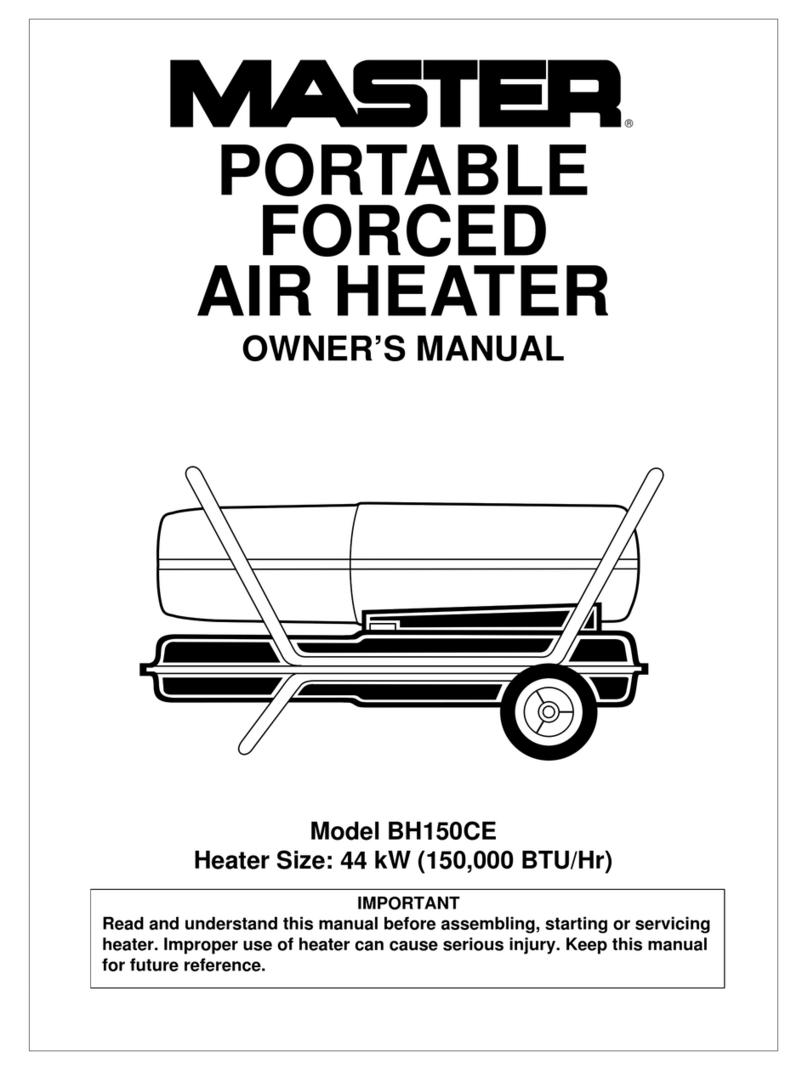
Masterlock
Masterlock BH150CE owner's manual
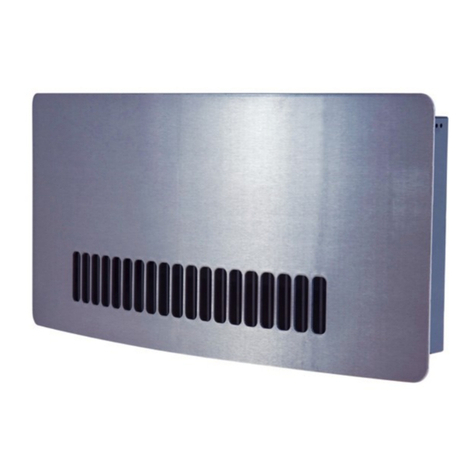
Consort
Consort WMH3SL Installation & Control Guide

Elnur Gabarron
Elnur Gabarron SOLARHHR20 User operating instructions
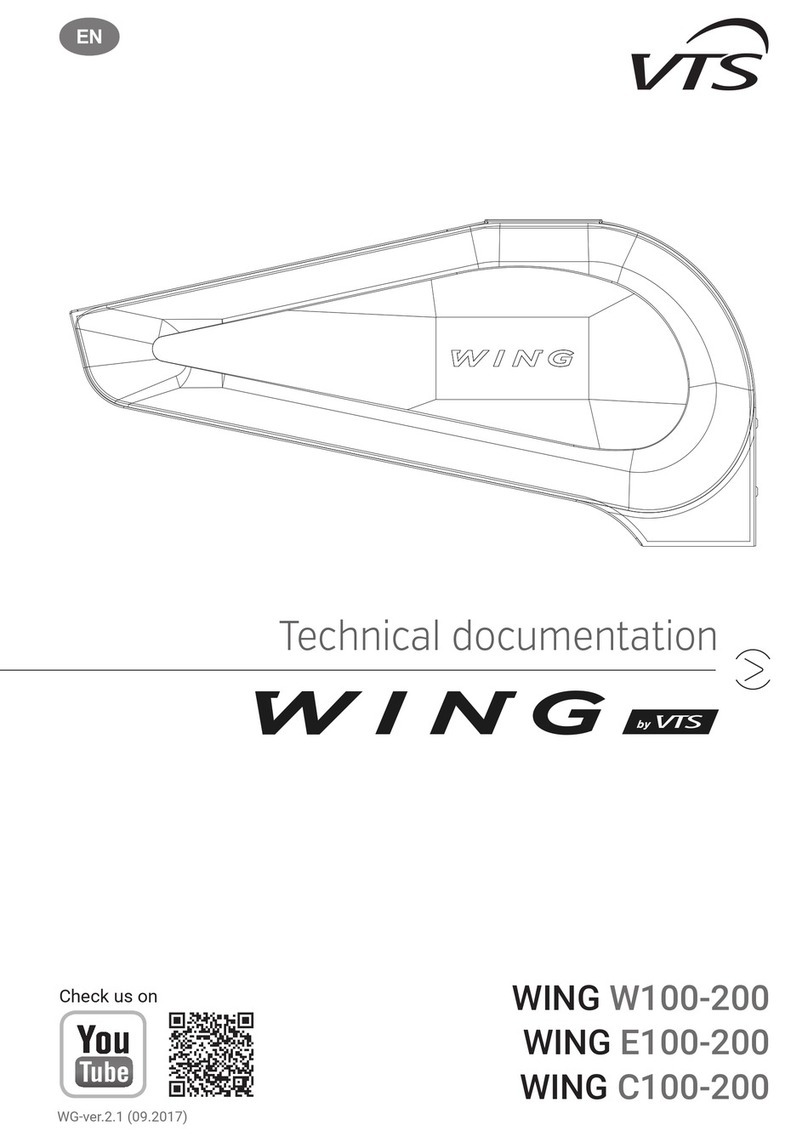
VTS Medical Systems
VTS Medical Systems WING W Series Technical documentation
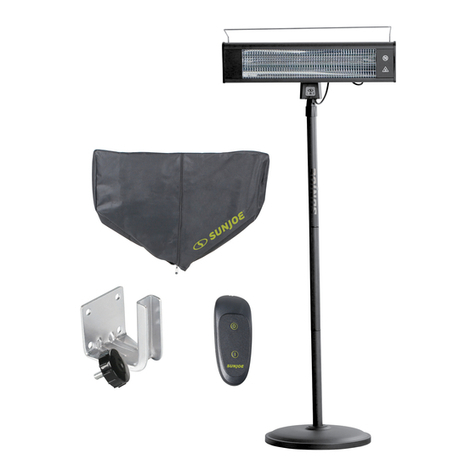
SNOWJOE
SNOWJOE Sunjoe SJPH1500E Operator's manual
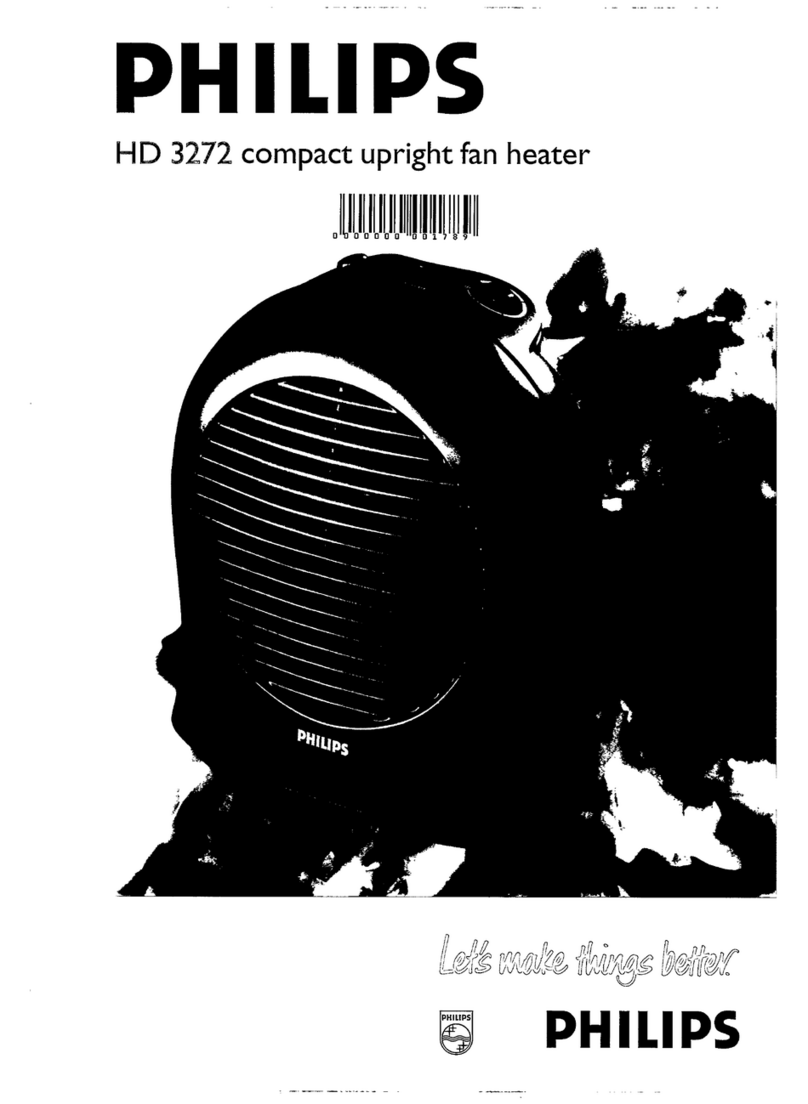
Philips
Philips HD3272/10 Technical specifications
